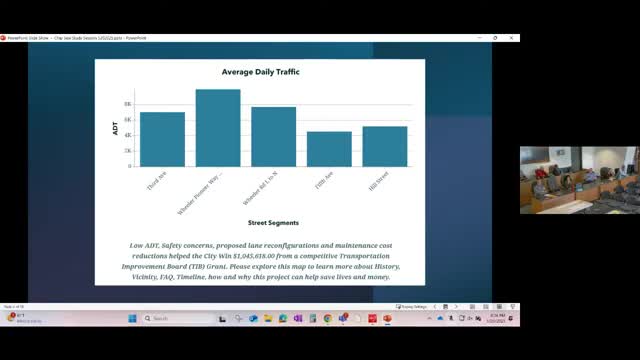Moses Lake discusses Third Avenue restriping to enhance traffic flow and save costs
May 22, 2025 | Moses Lake City, Grant County, Washington
This article was created by AI summarizing key points discussed. AI makes mistakes, so for full details and context, please refer to the video of the full meeting. Please report any errors so we can fix them. Report an error »

In the heart of Moses Lake, city officials gathered under the bright lights of the council chamber to discuss a transformative project aimed at enhancing local streets and improving community safety. The meeting, held on May 22, 2025, focused on the proposed restriping of Third Avenue, a vital thoroughfare that sees less than 2,000 vehicles daily. This initiative, which began discussions last year, aims to reconfigure the street from four lanes to two, prioritizing vehicle movement while also considering access to local businesses.
City planners highlighted the importance of this project, noting that it is part of a larger strategy to optimize the transportation network in Moses Lake. With a million-dollar grant from the Transportation Improvement Board (TIB), several streets, including Third Avenue, Dogwood, and Fifth Division, are set to receive funding for improvements. The timeline for these enhancements has been carefully laid out, with community engagement through open houses and collaboration with local business associations already underway.
As the discussion unfolded, officials emphasized the need for fiscal responsibility. "At the end of the day, it all boils down to money," one planner remarked, stressing the importance of stretching taxpayer dollars while still achieving effective transportation solutions. The council is keenly aware of the balance required between expanding the road network and maintaining the integrity of existing infrastructure.
The conversation also touched on the broader implications of street design. While some cities opt for extensive lane additions to alleviate congestion, Moses Lake is taking a different approach. The planners expressed a desire to avoid creating "superblocks," which can lead to increased traffic and reduced local business patronage. Instead, they aim to create a more interconnected network that allows for shorter, more efficient travel routes.
Cost considerations were a significant part of the meeting, with officials detailing various maintenance strategies and their associated expenses. For instance, crack sealing and chip sealing are cost-effective methods to preserve pavement, while full reconstruction can be significantly more expensive. The planners also noted the potential complications of aging infrastructure, such as outdated water lines, which could necessitate further excavation after new improvements are made.
As the meeting concluded, the council members left with a clearer vision of how to enhance Moses Lake's streets while being mindful of budget constraints and community needs. The project promises not only to improve traffic flow but also to foster a safer environment for residents and visitors alike, setting the stage for a more vibrant and accessible city.
City planners highlighted the importance of this project, noting that it is part of a larger strategy to optimize the transportation network in Moses Lake. With a million-dollar grant from the Transportation Improvement Board (TIB), several streets, including Third Avenue, Dogwood, and Fifth Division, are set to receive funding for improvements. The timeline for these enhancements has been carefully laid out, with community engagement through open houses and collaboration with local business associations already underway.
As the discussion unfolded, officials emphasized the need for fiscal responsibility. "At the end of the day, it all boils down to money," one planner remarked, stressing the importance of stretching taxpayer dollars while still achieving effective transportation solutions. The council is keenly aware of the balance required between expanding the road network and maintaining the integrity of existing infrastructure.
The conversation also touched on the broader implications of street design. While some cities opt for extensive lane additions to alleviate congestion, Moses Lake is taking a different approach. The planners expressed a desire to avoid creating "superblocks," which can lead to increased traffic and reduced local business patronage. Instead, they aim to create a more interconnected network that allows for shorter, more efficient travel routes.
Cost considerations were a significant part of the meeting, with officials detailing various maintenance strategies and their associated expenses. For instance, crack sealing and chip sealing are cost-effective methods to preserve pavement, while full reconstruction can be significantly more expensive. The planners also noted the potential complications of aging infrastructure, such as outdated water lines, which could necessitate further excavation after new improvements are made.
As the meeting concluded, the council members left with a clearer vision of how to enhance Moses Lake's streets while being mindful of budget constraints and community needs. The project promises not only to improve traffic flow but also to foster a safer environment for residents and visitors alike, setting the stage for a more vibrant and accessible city.
View full meeting
This article is based on a recent meeting—watch the full video and explore the complete transcript for deeper insights into the discussion.
View full meeting
